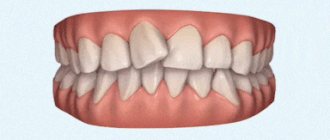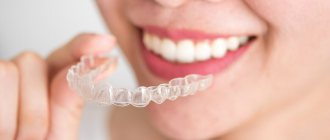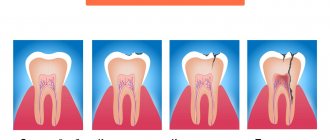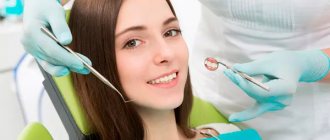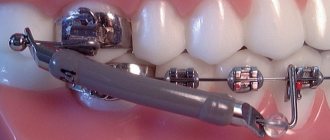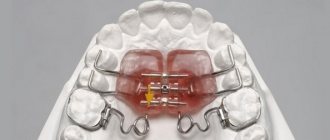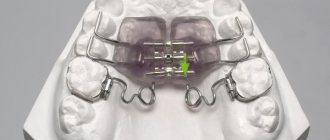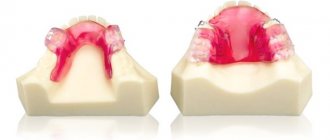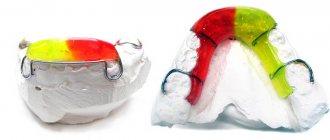7227
Modern orthodontics is designed to solve a person’s problems with the arrangement of individual teeth and the entire dentition as comfortably and quickly as possible.
Many patients are sure that only braces are used to straighten teeth, but this is not the case.
The Derichsweiler apparatus helps to expand the upper jaw and make a person’s smile smooth and beautiful.
Design and principle of operation
The Derichsweiler apparatus consists of elements :
- plate made of plastic or metal;
- metal screw;
- hooks, wire arches.
This design is located at the top of the palate, cast arches are attached to the side teeth, exerting pressure on them . The plate inside is equipped with a screw and metal fittings - hooks, which are fixed on the supporting molars.
Having securely fastened the device, the doctor looks at the effect it has on the teeth.
In addition to jaw expansion, there is also the movement of certain teeth that need correction.
During the treatment process, the design undergoes changes - a metal screw is tightened, which increases the area of the plate and increases the pressure.
The screw allows you to apply a gradually increasing load on the teeth, thereby fixing their displacement.
In addition to the problem of a narrow jaw, another, accompanying problem is solved - gaps between the teeth. As a result of pressure on the molars, incisors and premolars, these gaps are eliminated using springs and screws.
Distractor for the lower jaw
This device stands out among other devices. It consists of a smooth body on which a self-expanding screw and slide are placed, and there are also levers with wedge-shaped ends. With its help, crossbite is corrected.
The device eliminates the anomaly and fills the emerging space in the bone tissue. The design has different types, they are aimed at solving various problems that are associated with a narrowing of the dental arch. This allows the use of a distractor to treat children.
Indications for use
The Derichsweiler apparatus is necessary for patients who have the following problems :
- the upper jaw is too narrow, this is determined by the relationship between the upper and lower teeth, sometimes a person experiences difficulty chewing food, speaking and aesthetic discomfort;
- with crowding of molars, premolars in the upper jaw;
- in the presence of crossbite;
- if the fangs on the upper jaw grow incorrectly, out of place.
If these problems exist, dentists choose this particular device, as it allows you to effectively straighten your teeth in a short period of time .
Facebow
Used in adolescence in growing patients up to 12-13 years of age. The use of this device is effective in cases of predominant growth of the upper jaw and the goal of treatment on the face bow is to move the teeth in the upper jaw posteriorly.
Indications for use:
1. Distal bite. 2. Early loss of chewing milk teeth and displacement of the permanent 6 teeth. 3. To inhibit the growth of the upper jaw.
Wearing mode:
The orthodontist always recommends wearing it 24 hours a day. But in reality we're hoping for night, evening and weekend wear. Those. The face bow must be in the mouth for more than 12 hours a day.
Wearing period:
Most often, a facebow is prescribed together with a brace system (partial 4*2) or full. And it is used until the target is achieved (6-18 months).
Contraindications
The Derichsweiler apparatus is used up to the age of 20-23 years.
Its use is indicated for everyone who has the problems listed above. The only contraindication is an allergic reaction to metal or plastic that is part of the device.
It is not recommended to actively use it in case of cleft of the soft and hard palate, since with this defect an operation is performed to tighten the palatal suture, and the device just widens this suture.
In such a case, the treating orthodontist makes his verdict. After all, with this defect there are a lot of concomitant pathologies of tooth growth.
Indications and contraindications for expanding the dentition
Opening of the palatal suture is carried out strictly for medical reasons:
- with insufficient width of the lateral sections of the jaws in crossbite,
- reduction of the apical base and perimeter of the jaw arch,
- protrusion of incisors,
- micrognathia,
- breathing problems due to insufficient volume of the nasal cavity.
Despite their high efficiency, hardware-assisted palatal expansion techniques are not suitable for everyone. Devices for opening the palatal suture cannot be used:
- with asymmetrical crossbite,
- weak periodontitis,
- anterior open bite,
- skeletal asymmetry of the upper jaw.
The possibility of installing a device to expand the jaw arch is determined by an orthodontist. If installation is not possible, surgical treatment may be recommended to the patient.
Advantages and disadvantages
In orthodontics, there are several methods for treating narrowness of the upper jaw.
But the Darichsweiler design has several advantages over them:
- the patient gets quick results, after a short treatment there is a noticeable expansion of the upper jaw;
- a person quickly gets used to the device, even if at first he experiences discomfort when wearing it;
- This device is used along with other methods of teeth straightening, for example, braces.
Using this mechanism, a person gets quick and high-quality results.
But when using it, patients sometimes experience complications. They are the disadvantage of this device.
When used in childhood, the child's palate may open. If you start treatment before the molars grow, you can avoid negative consequences.
This is due to the fact that in early childhood the palatine lobes have not yet completely fused, which allows for a good result to be achieved.
Correct bite with a plate: Haas apparatus for palatal expansion
Correct bite with a plate : Haas apparatus for palatal expansion
“The child’s teeth are growing crookedly, his jaw is small, what should I do?” - this is a question that mothers and fathers often ask us.
This article is for you if your child…
- Crowding and narrowing of the jaw row
- A tooth (often a fang) has erupted crookedly
- No room for teething
- Difficulty breathing
- Mouth won't close
We often encounter the problem of narrowing of the upper jaw in our patients in childhood and adolescence, so we pay great attention to educating parents in this regard.
Bite correction with plates and aligners is a branch of orthodontics. For a proper smile, the size and shape of not only the teeth are important, but also the relationship of the dentition, the nature of closure and overlap.
At an early age, the technique of opening the median palatal suture can be very useful, since with qualified treatment the patient retains all teeth and there is no need to remove healthy teeth . In addition, at a young age, the tissue quickly regenerates and the healing process is smooth and painless with minimal risk of relapse and recession.
What is recommended in our dental clinic in Zelenograd ?
One of the most popular devices today is the development of the German orthodontist Andrew J. Haas - the Haas apparatus, which was subsequently improved by the Italian professor Marco Rosa.
Haas appliance is a non-removable mechanical device for moving teeth and jaws.
It includes the following elements:
- metal frame made of medical steel, which prevents the development of an allergic reaction;
- plastic plates that form the support area;
- Hyrex screw, which directly creates expansion force;
- rings and clasp for fastening.
Question: “How is the principle of installation and treatment constructed?”
Dentist Ekaterina Viktorovna Didenko answers: “First, the patient undergoes an examination, photographs and impressions are taken, then an individual mouth guard is made by a dental technician. The device is secured to the primary canines and chewing teeth of the upper jaw with dental cement. Due to the pressure of the screw and its constant tightening, the palatal suture opens. The resulting space is filled with bone tissue over time.
Advantages of Haas apparatus
- No need to grind down healthy teeth
- Easy to mount
- Unnoticeable in the mouth
- No need to remove to eat or brush teeth
- Short treatment period
- Reducing the period of treatment with braces in the future
In order to avoid discomfort, chafing and soreness during the adaptation period, you need to follow the rules of hygiene and nutrition. At first, there may be increased salivation and a feeling of nausea during swallowing, but this goes away as you get used to the plate.
But the result is worth it! As a result, the proportions of the dentition and the method of closure are normalized; accordingly, the proportions of the face become more symmetrical and more beautiful, which is important for teenagers. The cost of our dentistry in Zelenograd ranges from 10 thousand. Rub. Come for a consultation, we will be glad to see you!
Contact us, Zelenograd, building 2008, building 1651.
Manufacturing process
To manufacture the device, you need to perform some manipulations with a doctor.
- At the first consultation, the specialist takes an impression of the teeth, which must be done very carefully, because the effectiveness of the treatment and the duration of the patient’s adaptation depend on this.
- First, the deepest part of the palate and torus is isolated, for which the doctor makes a gasket, no more than 4.5 mm in thickness.
- The interdental papillae of the gums and the front part of the palate are relieved of pressure.
- The plate itself is made of transparent plastic, which greatly facilitates the process of correction and monitoring the state of the sky under the plate.
- After fitting the device to the patient, the device is checked on a plaster model of the jaw, and the ability of the screw to work is assessed.
We will tell you how the Brückl-Reichenbach apparatus works in a separate article.
In this publication we will compare the appearance of diastemas before and after therapy.
Here https://orto-info.ru/sistemyi-vyiravnivaniya-zubov/breketyi/po-raspolozheniyu/vestibulyarnyie/victory.html you will find a review and photo of Victory braces.
Installation sequence
The accuracy of installation of the mechanism is important for the patient, because he will feel a foreign body in the oral cavity for at least another 3 months.
Treatment takes place in several stages:
- After checking the screw mechanism and adjusting the plate on the plaster jaw, the device is installed on the patient . The patient is given a day to master the device. At this time, he learns to use it and gets used to it.
- Then the patient, if nothing bothers him, has crowns and rings attached to his molars using special dental cement.
- 24 hours after fastening, the doctor begins the treatment process: the screw is unscrewed .
- Every day the screw is activated half a turn, the doctor and the patient monitor the condition of the device in the oral cavity and general well-being.
If the pain after turning the screw disappears within a minute, then you can continue treatment.
It is important not to overtighten the screw - this can lead to complications. If you add a little pressure, you may experience pain in the temples and bridge of the nose. In this case, the doctor returns the screw a little back.
After just a week, you can see the first result of the device - a diastema appears between the front teeth - a gap that grows and then goes away. There is a gradual alignment of the teeth.
Upon completion of treatment:
- the side teeth fall into place,
- the sky slightly increases its area,
- the lower part of the face visually becomes larger,
- the lower jaw falls into place,
- teeth align their position.
At what stage of bite correction is the Derichsweiler apparatus used, look at the video:
When the process of tightening the screw is completed, it is covered with a plastic plate for the patient’s convenience and to minimize discomfort.
Cost of the device
Since the Derichsweiler apparatus is custom-made for each patient, its cost will be relatively high. The price depends on the type of material from which the orthodontic device is made. It may also change depending on the region of your residence and the prices of a particular medical institution.
The exact price will be known only after an examination by a specialist, so it is better to contact your nearest dental clinic on this issue. There you will be given a full examination and the approximate cost of treatment will be given. It will consist of a preliminary inspection, manufacture and installation of the device.
From this article you learned all the most important things about the Derichsweiler apparatus and understood in what cases its use is appropriate. Similar devices are also available for correcting defects of the lower jaw. They also come with a screw and fasteners. In conclusion, we invite you to watch a video in which you will find a real history of treatment using this device and braces.
How long to wear?
During the consultation, the orthodontist determines the approximate timing depending on the degree of anomaly in the position of the teeth.
The process of tightening the screw can last from a week to 2-3 months. It also depends on the age of the patient and the process of adaptation to the device. If any complications arise during treatment, more time will be required for alignment.
After tightening the screw, a period of retention follows - maintaining the achieved result . This is a very important time, because if it is not organized correctly, all efforts come to nothing.
The device stays in the oral cavity for a total of 2-3 months.
Design of the Derichsweiler apparatus
The design of the system consists of a base, fasteners, a screw with springs. More details:
- The base is a plate made of metal or plastic. If you decide on the choice of material, then metal is a fairly hard material, so it can cause some discomfort. However, the use of metal structures significantly reduces treatment time. If we talk about plastic devices, they are convenient to use, but are unable to provide the proper pressure, due to which the time required to correct defects increases significantly. There are also combined options.
- There is a metal screw in the middle of the base; the Derichsweiler apparatus will have to be tightened independently to increase the area of the plate (we will consider the principle of operation of the system below).
- Along the edges of the base there are ring-hooks (a kind of arc-shaped clamps), made of metal 1–1.2 mm thick. These retainers are attached to molars or premolars. Depending on the type of pathology, they can also be attached to the fangs.
- As additional elements, the design can have a variety of springs and screws. Their task is to help remove or prevent the formation of gaps between teeth. Sometimes, during the process of expanding the palate, this effect occurs due to the displacement of dental units.
The Derichsweiler apparatus is manufactured individually, taking into account the size of the oral cavity and the patient’s existing problems.
Possible complications
Complications during treatment with the Derichsweiler apparatus include dehiscence of the palate suture . This occurs due to weak tissues or too much pressure on the teeth. Sometimes it is difficult to adjust the position of the screw correctly.
The occurrence of persistent pain is also a complication of treatment with this device.
Early diagnosis and prevention as the key to successful treatment
To prevent the formation of a narrow palate, you need to know the reasons for the development of this pathology. Some of them can be avoided, and some will be a reason to seek help early.
- Patients who have a hereditary predisposition need to be wary. An existing defect in one of the parents should be a reason for early diagnosis, as well as timely treatment.
- The next reason for the development of a narrow palate is bad habits. Parents of the baby should pay attention to the child’s sucking of fingers, toys, and prolonged use of pacifiers (the latter should not be in the baby’s cavity for more than 7 hours/day). The first violations can be corrected with special plates. For example, “MUPPY” bite correction plates. The missed moment in the development of pathology will have to be corrected with the Derichsweiler apparatus, but even here parents need to remember that good results can only be achieved until the limited age of their child. And timely use of the design increases the chances that the baby will not have to correct the bite in the future using braces.
- Another disorder that leads to the development of a narrow palate is the child’s mouth breathing. To prevent the development of disorders, you can also use plates, but if during an examination the doctor advises you to use the Derichsweiler apparatus, you should not refuse. When the baby's palatal suture opens, the shape of the bottom of the nasal cavity will begin to change. This will help straighten the nasal septum. Air streams will be easier to pass through, and breathing itself will improve.
The Derichsweiler apparatus is one of the most effective ways to eliminate the problem of narrow palate pathology. The design is often the only option when, without its use, it is impossible to correct the bite. For a patient who wants to get a positive result quickly, this is an excellent solution.
Sources used:
- Kurlyandsky V. Yu. Orthopedic dentistry. — 4th, corrected. - M.: Medicine, 1977.
- Proffitt W.R., Modern orthodontics (3rd edition), MEDpress-inform, 2015.
- Klineberg I., Jaeger R. Occlusion and clinical practice. - 2nd ed. - M.: MEDpress-inform, 2008.
Care instructions
Since the device is not removable, but is constantly in the oral cavity, it must be carefully looked after. Food debris accumulates between the wire and the teeth, forming plaque, which must be carefully cleaned with a medium-hard brush .
The patient periodically needs to visit the dentist or hygienist to clean all the hard-to-reach areas between the appliance and the teeth. The patient receives cleaning instructions each time a screw is tightened.
It is imperative to comply with the requirements for oral care, especially if other orthodontic systems are used together with the device.
In this case, it is better to rinse your mouth after each meal and not to eat hard, hard foods .
What is the price?
All individual designs have a fairly high price, because they are not produced on a conveyor belt, which means that their production takes more time and effort. The price for each patient depends on several criteria :
- material for making plates, crowns and rings;
- region of residence of the patient;
- prices for doctor's services, which are determined for each medical institution.
After the inspection, the specialist can tell you the approximate price for the device.
The device itself can be purchased at a price of 8,500 rubles .
But the total cost will also include consultation with a specialist, manufacturing of the mechanism and its installation. In addition, the patient comes to tighten the screw, which is also paid for.
How does crossbite manifest in children and what are the differences in the methods of influencing it?
In this article, we will discuss how much teeth straightening trays cost and what factors influence the price.
At the link https://orto-info.ru/zubocheliustnye-anomalii/okklyuzii/glubokiy-prikus.html we published a selection of photos of how the face changes with a deep bite.
Types of fixed devices
I prefer devices from leading dental brands. We will decide which option is right for your child after examination and diagnosis. We will select a model that corrects the defect, is positively perceived by the young patient, and is affordable financially.
Haas/Marco Ross devices
This is a new level of defect correction. The device was first introduced by Mark Ross - he used a titanium screw. But Andrew Haas improved the design by using a stronger and more powerful screw - the Hyrex screw.
The corrective structure is assembled from a screw, a base made of light plastic, support rings and grips (“claws”) made of metal for fixation on primary chewing teeth, and is attached to temporary fangs with filling material. Such devices allow you to expand the upper jaw as much as the situation requires. They are made from a mold for each baby. If the anomaly is complicated, then the modifications are supplemented with other necessary elements.
The device is installed so that the jaw is formed adequately, and there is a place for each tooth. Its advantages:
- Comfortable to wear, beautiful, you can choose the color of the plastic or the pattern. Unnoticeable to others, but the baby knows that there are amazing butterflies and simply beautiful products in his mouth.
- Attaches firmly.
- The addiction is quick, the discomfort in the first days is minimal.
- Simple application - the screw is tightened, the palatal suture expands and stimulates the correct formation of the jaw.
The device will cope with bite correction independently or, in difficult cases, will reduce the period of follow-up treatment in adolescents with a brace system from 12-18 months. up to six months.
Distal Jet
A gentle device that initiates movement of the first and second molars without tilting or rotation. The effect is visible after 3-4 months. It consists of a solid plastic palate, fastening rings for chewing units and an activation screw responsible for the smooth movement of the teeth. Treatment of adults and adolescent children is possible.
Career motion 3D
Often used as preparation for installing braces. The task is to gently shift the lateral units of the jaw back. This is an upper partial arch plus a bracket for the lower molars. Class 2 elastics are used, suitable for teenage children and adults.

